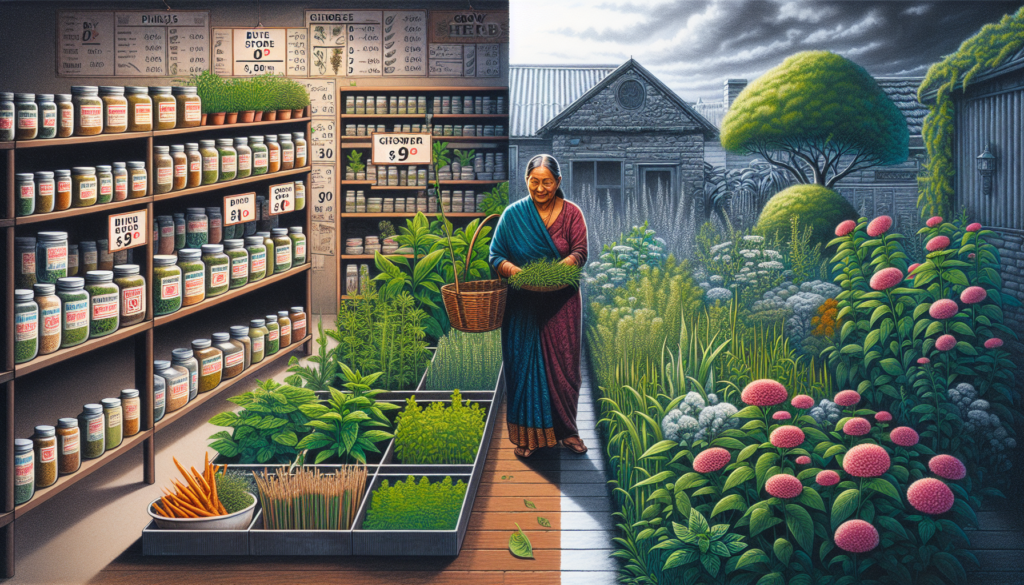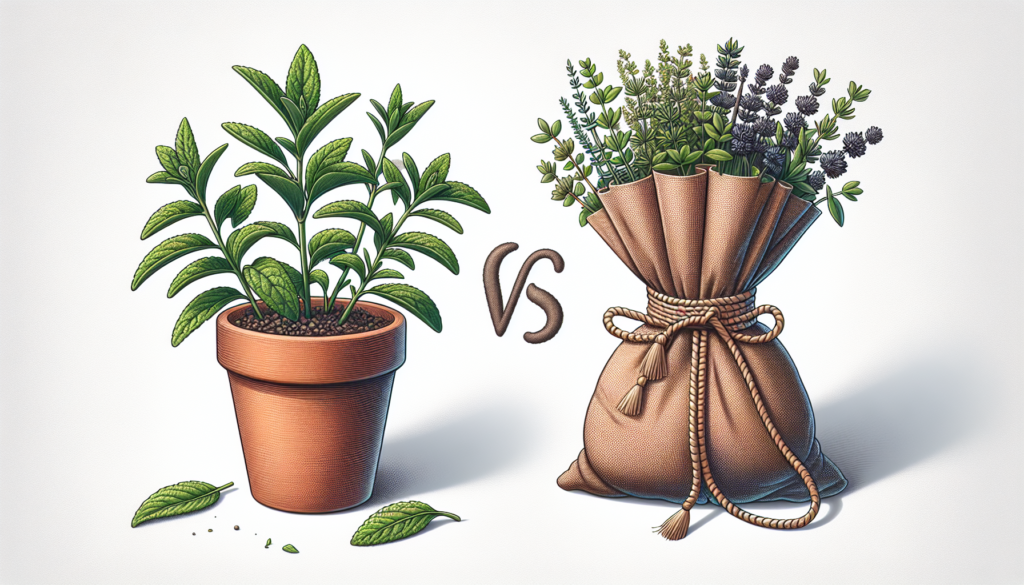So, you love adding a little bit of fresh flavor to your dishes with herbs, but you’re wondering if it would be more cost-effective to buy them at the store or grow them yourself. Well, let’s break it down for you. On one hand, buying pre-packaged herbs from the grocery store is convenient and saves you time. But on the other hand, growing your own herbs can be a rewarding and sustainable option. Let’s explore both sides to find out which option wins in the battle of cost versus convenience.

Cost Comparison
When it comes to the cost of herbs, there are two options: buying them from a store or growing them yourself. Both options have their own set of expenses and benefits. In this article, we will explore the cost comparison between store-bought herbs and growing your own.
Cost of Store-bought Herbs
Store-bought herbs are readily available and convenient. However, they can be quite expensive in the long run. The price of store-bought herbs varies depending on the type of herb, its availability, and the store itself. Generally, you can expect to pay a premium for packaged fresh herbs compared to dried herbs. If you use herbs frequently in your cooking, the cost can add up quickly.
Cost of Growing Herbs
Growing your own herbs can be a cost-effective alternative to buying them from a store. Although there is an initial investment involved, the long-term savings can outweigh the upfront expenses. Let’s break down the different factors that contribute to the cost of growing herbs.
Initial Investment
Before you can start growing your own herbs, you will need to invest in a few essential items. These include the seeds or seedlings, containers and planters, soil, fertilizers, and tools or equipment.
Seeds or Seedlings
The first step in starting your own herb garden is acquiring the seeds or seedlings. Seeds are generally more affordable, and you can find a wide variety of them at a relatively low cost. On the other hand, if you prefer a more convenient option, you can purchase small herb plants or seedlings from a nursery. These might be slightly more expensive upfront but can save you time and effort in the long run.
Containers and Planters
Herbs can be grown in various containers and planters, ranging from traditional clay pots to hanging baskets or even vertical gardening systems. The cost of containers will depend on their material, size, and design. While you can choose to recycle old containers or repurpose household items, investing in sturdy and purpose-built containers can improve the overall growth and aesthetics of your herb garden.
Soil and Fertilizers
The quality of soil and fertilizers you use will greatly impact the growth and health of your herbs. While you can prepare your own compost and organic fertilizers, purchasing them from a garden center might be a more convenient option. Keep in mind that the initial investment in good soil and fertilizers can lead to healthier plants and a higher yield in the long run.
Tools and Equipment
To properly maintain and care for your herb garden, you may need basic gardening tools such as a trowel, shears, watering can, and gloves. While these tools might not be expensive, they are essential for efficient and effective gardening. Consider investing in high-quality tools that will last longer and make your gardening experience easier.
Annual Expenses
In addition to the initial investment, there are also ongoing annual expenses associated with growing herbs. These include watering and irrigation, electricity and lighting, fertilizers and supplements, pest control, and replacement plants.
Watering and Irrigation
Proper watering and irrigation are crucial for the health and growth of your herbs. Depending on the climate and the type of herbs you’re growing, you may need to water them daily or at regular intervals. The cost of watering your herbs will depend on your water source and whether you choose to hand water or invest in an automatic irrigation system.
Electricity and Lighting
If you’re growing herbs indoors or in a controlled environment, you may need to supplement natural light with artificial lighting. High-quality grow lights can be expensive, but they are a worthwhile investment for ensuring optimal growth and yield. Consider energy-efficient options to minimize electricity costs over time.
Fertilizers and Supplements
To provide your herbs with the necessary nutrients, you may need to use fertilizers and supplements. Organic options can be more expensive than synthetic ones, but they are often preferred for their environmental benefits. Assess the specific needs of your herbs and choose fertilizers accordingly to maximize their growth potential.
Pest Control
Keeping pests away from your herb garden is essential for healthy plants. There are several organic pest control methods you can employ, such as companion planting and using natural insecticides. These methods might require additional expenses, but they are safer for both you and the environment.
Replacement Plants
Despite your best efforts, there is always a chance that some of your herb plants may not survive. Whether due to pests, disease, or other factors, you may need to replace certain plants from time to time. Factor in the cost of new plants when planning your annual herb garden budget.
Yield and Usage
The quantity of herbs you can yield from store-bought plants versus personal plants will directly impact the cost comparison between the two options. Let’s examine this aspect more closely.
Herb Yield from Store-bought Plants
When buying herbs from a store, the quantity you receive is typically predetermined, and it may not be sufficient for your needs. Additionally, packaged herbs have a limited shelf life, and they may not stay fresh for an extended period.
Herb Yield from Personal Plants
Growing your own herbs gives you more control over the quantity and quality of your yield. As you cultivate your plants, you can tailor your herb garden to suit your usage frequency. With proper care and maintenance, you can enjoy a continuous supply of fresh herbs throughout the growing season.
Usage Frequency
Consider how frequently you use herbs in your cooking. If you’re an avid cook who uses herbs in almost every meal, the cost savings of growing your own herbs can be substantial. On the other hand, if you only occasionally use herbs or prefer a limited variety, store-bought options might be more convenient and cost-effective.

Quality and Freshness
One significant advantage of growing your own herbs is the control you have over the growing conditions. This control directly impacts the quality and freshness of the herbs you harvest.
Pesticide and Chemical Usage
When you grow your own herbs, you have the choice to use organic growing methods, minimizing or eliminating the use of pesticides and chemicals. This ensures that your herbs are free from harmful residues and allows you to enjoy a healthier and more eco-friendly option.
Herb Shelf Life
Store-bought herbs often have a limited shelf life, especially when compared to fresh herbs straight from your garden. By growing your own herbs, you can harvest them at their peak freshness and use them immediately. This guarantees optimal flavor and aroma in your culinary creations.
Control over Growing Conditions
Growing herbs yourself gives you complete control over the growing conditions, including the type of soil, exposure to sunlight, and water quality. This control allows you to create the ideal environment for your herbs to thrive, resulting in healthier and more vibrant plants.
Space Requirements
Consider the available space you have for your herb garden, whether indoor or outdoor, as it will affect the cost and feasibility of growing your own herbs.
Indoor Herb Garden
If you have limited outdoor space or live in an apartment, an indoor herb garden can be a perfect solution. Indoor gardens often require additional investments in grow lights, shelving, and ventilation. However, they provide year-round access to fresh herbs and can be a convenient option for those with space constraints.
Outdoor Herb Garden
When you have sufficient outdoor space, creating an herb garden becomes more feasible. Utilizing existing garden beds or allocating a separate area for herbs can help keep costs minimal. Outdoor gardens benefit from natural light and require less investment in artificial lighting.
Vertical Gardening
Vertical gardening is a space-saving technique that can be adapted for both indoor and outdoor herb gardens. By utilizing walls, trellises, or hanging containers, you can maximize your herb production in a limited area. While there might be some initial expenses in setting up a vertical garden system, the long-term benefits in terms of space optimization can be significant.
Time and Effort
Growing herbs requires a certain amount of time and effort. Understanding the commitment involved can help you determine whether it’s a viable option for you.
Planting and Propagation
The initial planting and propagation process can vary depending on the chosen method and the specific herb. Starting from seeds may require more time and patience compared to using seedlings. Consider the time you’re willing to dedicate to the initial setup before making a decision.
Maintenance and Care
Herb plants need regular maintenance and care to ensure their health and productivity. This involves watering, pruning, weeding, and monitoring for pests or diseases. Plan for the time required to tend to your herb garden on a weekly basis and evaluate whether it aligns with your schedule.
Harvesting and Processing
The joy of growing your own herbs lies in harvesting them when they are at their peak. Harvesting can be a satisfying and enjoyable process if you allow yourself enough time. Additionally, consider the time required for processing and preserving herbs for future use, such as drying or freezing.
Knowledge and Skills
Growing herbs successfully requires some level of knowledge and skill development. Assess your gardening know-how and culinary skills to ensure that you can properly care for and utilize the herbs you grow.
Herb Gardening Know-how
Familiarize yourself with the specific requirements of the herbs you intend to grow. Research their preferred growing conditions, watering needs, and any potential challenges they may face. Understanding the basics of herb gardening will greatly increase your chances of success.
Plant Care and Troubleshooting
Knowing how to identify and address common plant problems is essential for maintaining the health of your herbs. Be prepared to learn about pest control, disease prevention, and nutrient deficiencies. Developing the skills to troubleshoot any issues that arise will ensure a thriving herb garden.
Culinary and Preservation Skills
Growing your own herbs opens up a world of culinary creativity. Consider your culinary skills and willingness to experiment with different recipes and flavors. Additionally, explore the various methods of preserving herbs, such as drying or making herb-infused oils, to extend their usability beyond the growing season.
Personal Satisfaction
Beyond the financial considerations, growing herbs can bring personal satisfaction and a connection to nature. Let’s explore some of the intangible benefits of cultivating your own herb garden.
Gardening as a Hobby
Many people find joy and relaxation in tending to plants and gardens. Gardening can be a therapeutic and rewarding hobby that allows you to connect with nature and escape from the stresses of everyday life. The sense of accomplishment and pride that comes with growing your own herbs can be deeply satisfying.
Self-sufficiency and Sustainability
Growing your own herbs contributes to a sense of self-sufficiency and sustainability. By reducing reliance on store-bought herbs, you become more self-reliant in meeting your culinary needs. Additionally, growing your herbs organically fosters sustainability and helps reduce your carbon footprint.
Connecting with Nature
The act of gardening immerses you in the natural world and allows you to witness the beauty of plant growth and the changing seasons. Engaging with nature has been shown to have positive effects on mental and emotional well-being. Growing herbs can be a way to reconnect with the earth and appreciate the simple pleasures of life.
Convenience and Accessibility
While growing your own herbs offers numerous benefits, it’s essential to consider the convenience and accessibility aspects as well.
Buying Herbs Conveniently
No doubt, purchasing herbs from a store is convenient. They are readily available, saving you time and effort in growing and maintaining your own herb garden. If convenience is your top priority, store-bought herbs might be the better option for you.
Availability of Fresh Herbs
Depending on your location, the availability of fresh herbs in stores might be limited, particularly for certain varieties or during specific seasons. By growing your own herbs, you can ensure a constant supply of fresh herbs, regardless of their availability in stores.
Accessibility for People with Limited Mobility
For individuals with limited mobility, maintaining an outdoor herb garden can be challenging. In such cases, an indoor herb garden or vertical gardening system can provide a viable solution. These options allow easy access to herbs without the need for excessive bending or physical strain.
In conclusion, the cost comparison between store-bought herbs and growing your own depends on various factors. While store-bought herbs offer convenience, growing your own herbs can be a cost-effective and rewarding endeavor. Consider the initial investment, ongoing annual expenses, yield and usage, quality and freshness, space requirements, time and effort, knowledge and skills, personal satisfaction, convenience, and accessibility when making your decision. Growing herbs not only provides financial savings but also allows you to embrace the joys of gardening, self-sufficiency, and a deeper connection with nature.





